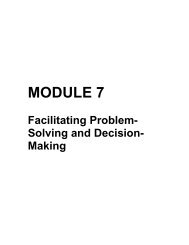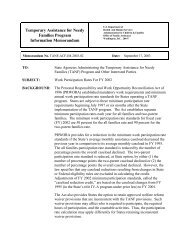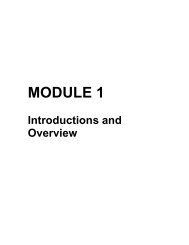Delivering Training and Technical Assistance - Administration for ...
Delivering Training and Technical Assistance - Administration for ...
Delivering Training and Technical Assistance - Administration for ...
You also want an ePaper? Increase the reach of your titles
YUMPU automatically turns print PDFs into web optimized ePapers that Google loves.
Key considerations <strong>for</strong> the IMPLEMENTATION PHASE include:• Can you practice <strong>and</strong> “set the room” ahead of time to prevent potential problems?• Are all of the materials ready?• Do you have contingency plans if media doesn’t work or if participants need other options?• Are you prepared to incorporate adult learning principles into your facilitation? (see the next section <strong>for</strong> morein<strong>for</strong>mation)• How will you ensure that participants are “present”?• How will participants identify their personal learning goals?• Have you thought through which facilitation techniques you will use?• Have you considered how you might use blended learning? (see the section on blended learning in thisguidebook <strong>for</strong> more in<strong>for</strong>mation)• Are you starting with an engaging activity?• Have you thought through what might cause you to stray from the lesson plan <strong>and</strong> what alternatives you mightkeep in your back pocket?EvaluateEvaluation occurs at every point along the way: analysis, design, development, <strong>and</strong> during <strong>and</strong> afterimplementation. It is an ongoing process. In the early phases, you are evaluating the work you have done <strong>and</strong>your preparedness to move onto the next phase.The design phase is a good time to identify the intended outcomes of the training session <strong>and</strong> their indicators,because you are developing the learning objectives. You would ask yourself how you would know theobjectives had been met <strong>and</strong> what kind of impact the session should have on participants’ behaviors.During implementation, you are evaluating your participants’ knowledge <strong>and</strong> body language <strong>and</strong> adaptingyour session as you go to meet their needs. To help participants retain more in<strong>for</strong>mation, create time withinimplementation <strong>for</strong> reflection. The process of reflecting at the end of a training session is often done throughan evaluation <strong>for</strong>m to measure whether you met the objectives in the session. However, questions about whatparticipants disliked can deflect learning <strong>and</strong> retention by <strong>for</strong>cing the brain to focus on the useless pieces ofthe training session so soon after new knowledge <strong>and</strong> experiences were attained. Instead, you can conduct theevaluation through appreciative review, either instead of an evaluation <strong>for</strong>m or be<strong>for</strong>e an evaluation <strong>for</strong>m, tohelp participants retain the new knowledge. Sample questions asked in an appreciative review <strong>and</strong> evaluation<strong>for</strong>m can be found in the appendices.After implementation, you are evaluating whether the session led to changes in behavior <strong>for</strong> the participants.Great training organizations check back to see how these changes in behavior have affected the organization,its practices, <strong>and</strong> its outcomes.There are many benefits to evaluation. Evaluation in the early phases leads to high-quality trainingsessions. Evaluation during implementation leads to a more engaging <strong>and</strong> targeted session. Evaluation afterimplementation helps your organization improve services, prove impact, <strong>and</strong> gain funding.9
















